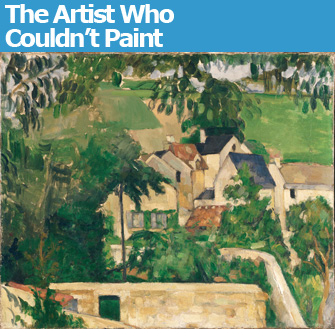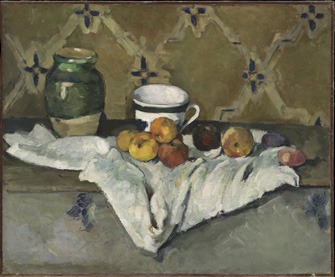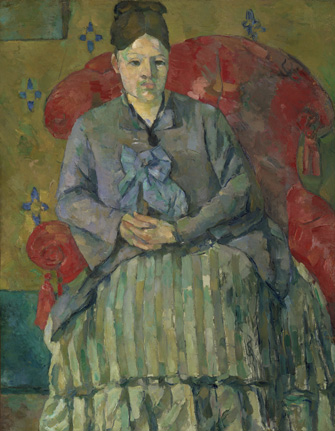 |
|
Cézanne’s “Le Quartier du Four à Auvers-sur-Oise” (c. 1873). © Philadelphia Museum of Art |
Paul Cézanne (1839-1906), the painter recognized by the great artists of the early 20th century as “the father of us all,” is perhaps best known for his obsessive …
 |
|
Cézanne’s “Le Quartier du Four à Auvers-sur-Oise” (c. 1873). © Philadelphia Museum of Art |
Paul Cézanne (1839-1906), the painter recognized by the great artists of the early 20th century as “the father of us all,” is perhaps best known for his obsessive painting of Mont Sainte Victoire in the South of France, but the curators of “Cézanne and Paris” at the Musée du Luxembourg point out that during his working life, he spent as much time in Paris as he did in Provence, producing 350 paintings in the Greater Paris area.
One of the theories they put forward is that the artist traveled to Paris for a break from the sunny glare of Provence and found a kind of serenity in the soft grays and green landscapes of the Ile de France that was impossible to find in the dry south (although the colors of the south sometimes crept into the paintings made in the north). “Paris was an escape from Provence,” said curator Maryline Assante di Panzillo at the opening of the exhibition. “It was necessary to his creativity.”
A few of the rare paintings he made in the city itself are on show here: one of a silent, empty street in Montmartre, another of the Paris rooftops seen from his window. A view of barges on the Seine at Bercy, painted after the same view by the Impressionist painter Armand Guillaumin (1841-1927), which hangs next to Cézanne’s version in the exhibition, gave Assante di Panzillo a chance to explain Cézanne’s revolutionary originality. At first glance, the work looks very similar to Guillaumin’s, but the curator pointed out how Cézanne, who was a contemporary of the Impressionists but was not one himself, juxtaposed short, flat strokes of pure color (as opposed to the dabs of the Impressionists) to “construct” the image and how he simplified the figures and objects, painting them with flat planes of color. “They thought he was crazy at the time,” she said. “People said he couldn’t paint.”
The artist who couldn’t paint is now generally considered the father of modern art. In the time-honored tradition, he learned his trade by copying paintings by the greats at the Louvre, which he called “the book from which we learn to write.” Some of his copies of paintings by Rembrandt (“Bathsheba”), Delacroix, Veronese and others are on show.
The exhibition amply illustrates Cézanne’s versatility, with street scenes, portraits, landscapes, nudes (mostly unappealing until he hit on the bathers-in-a-landscape formula that was so often copied by later artists, including Picasso and Matisse) and still lifes, including some of the wonderful apples that Woody Allen listed as one of the things that makes life worth living in his film Manhattan (more Cézanne
 |
|
“Poteries, Tasse et Fruits sur Nappe Blanche” (c. 1877) © The Metropolitan Museum of Art, Dist. service presse Rmn-Grand Palais/Malcolm Varon |
apples are on show in the “Matisse, Cézanne, Picasso: The Adventure of the Steins” exhibition at the Grand Palais).
One of the many fascinating paintings in the show is “Madame Cézanne à la Jupe Rayée” (1877), in which the artist’s wife sits placidly, hands folded, her gray-green-and-blue clothing and the wallpaper behind her contrasting with
 |
|
“Madame Cézanne à la Jupe Rayée” (c. 1877) © 2011, Museum of Fine Arts, Boston |
the bright red armchair she sits in. The curators describe her as being “as silent as an apple” in this “modern icon,” while the poet Rainer Rilke wrote of this work, “It’s as if each part of the painting were aware of all the other parts,” thus assuring the balance of the whole.
Cézanne never finished another wonderful portrait, of art dealer Ambroise Vollard, even after 112 sittings, because he was “unhappy with the shirtfront.” When you take a close look at the shirtfront in question, you see that what at first glance seemed to be an ordinary white shirtfront is made up of those touches of pure color Assante di Panzillo mentioned, in this case green, yellow and blue.
Among the explosions of green that are the landscapes, I especially loved “Rochers à Fontainebleau” (c. 1893), with its dark, stormy feel – even the rocks seem to be moving violently – but there are many other gorgeous landscapes in the show as well.
I could go on, but I’ll let you go see for yourself in this not-to-be-missed show.
Musée du Luxembourg: 19, rue de Vaugirard, 75006 Paris. Métro: Saint-Sulpice or Odéon. RER: Luxembourg. Tel.: 01 40 13 62 00. Open Friday-Monday, 9am-10pm; Tuesday-Thursday, 10am-8pm (during school holiday, daily 9am-10pm). Closed Christmas Day. Admission: €12. Through February 26, 2012. www.museeduluxembourg.fr
Order books on Cézanne from Paris Update’s Amazon store at no extra cost. Click on your preferred Amazon location: France, U.S.
Reader Reaction: Click here to respond to this article (your response may be published on this page and is subject to editing).
More reviews of Paris art shows.
© 2011 Paris Update
Favorite